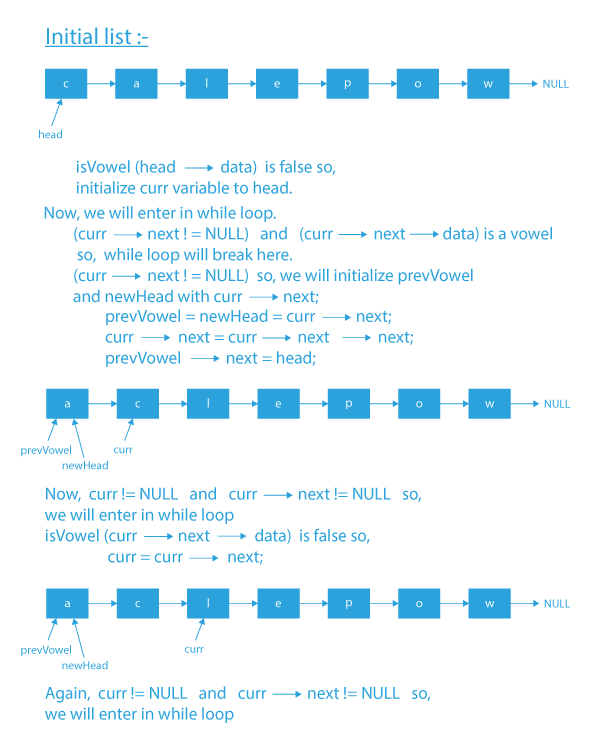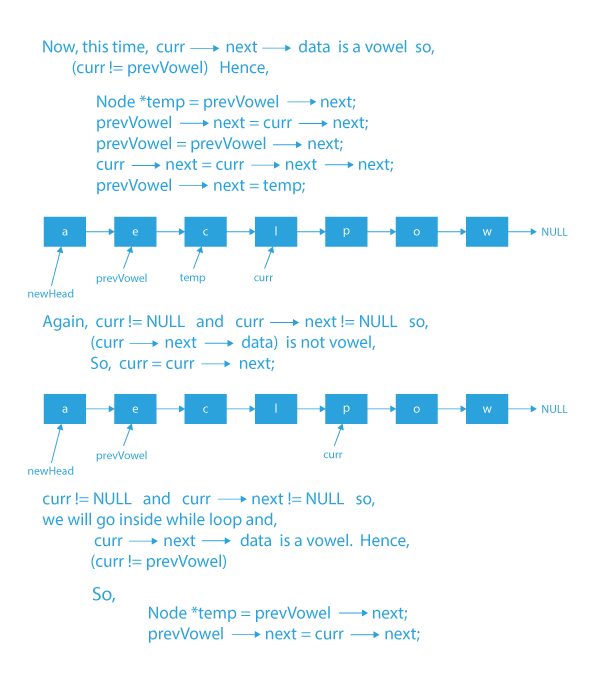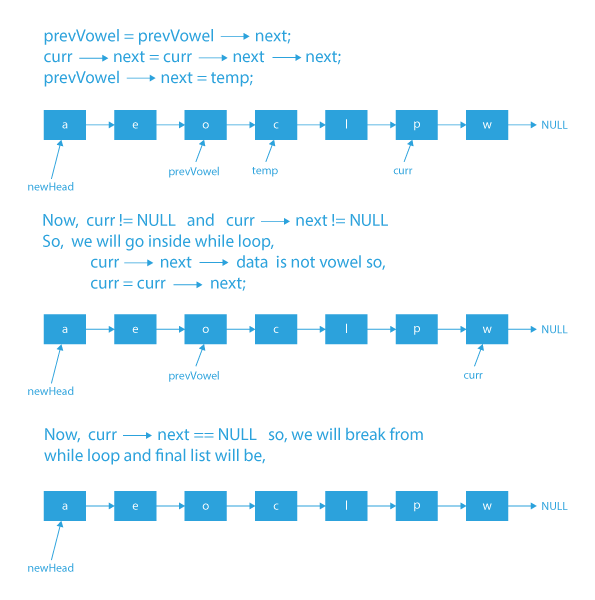This blog will give an efficient approach to arrange vowels and consonants in linked list. Arranging vowels and consonants in linked list will definitely help for better understanding of data structures like linked lists. Let’s discuss how to arrange vowels and consonants in linked list in detail.
How To Arrange Vowels And Consonants In Linked List
In this problem, we will be given a linked list in which each node will have an alphabet character as data, and we need to rearrange the nodes of the linked list so that all nodes having vowel data appear before the consonant ones.
Note:We are not allowed to disturb the relative order of vowels and consonants.
Let the given input be:
The output should be:
Let’s first understand the problem statement with the help of examples.
If the given linked list is c→a→l→e→p→o→w:
- Then, according to the problem statement, we need to rearrange the node of the linked list such that all the vowel nodes come before the consonant nodes. Also, we need to make sure that the order of occurrence of nodes within vowel nodes and consonant nodes after rearrangement should be the same as their order of occurrence in the original list.
- The output linked list after rearrangement of nodes will be a→e→o→c→l→p→w.
- In the output linked list, we can see that all the vowel nodes a, e, o are before the consonant nodes c, l, p and w. Also, if we notice carefully, we can observe that within vowel nodes and consonant nodes the order of occurrences of nodes is the same as their order of occurrence in the input list.
- The order of occurrence of vowel nodes in the input list is a, e, o and similarly in our output list, the order of occurrence of vowel nodes is the same a, e, o.
- The order of occurrence of consonant nodes in the input list is c, l, p, w and similarly in our output list the order of occurrence of consonant nodes is the same c, l, p, w.
Let’s take another example, say if the input list is: a→b→c→d→e→o→i→u
- In this case, our output singly linked list after rearrangement will be: a→e→o→i→u→b→c→d
Now, I think the problem statement is clear, so let’s see how we can approach it. Any ideas?
- The naive approach would be to create 2 vectors that would be storing the address of nodes. While traversing the list, insert vowel nodes in the first vector and consonant ones in the second one. Finally, create a new linked list, keeping all vowel nodes before consonant nodes.
The above approach will have a linear space and time complexity. But can we do better than this? Yes, we can improve the space complexity of our code to constant space.
- So, our idea will be to traverse the list and find the first vowel node. This will be the new head of our modified list. Now, we would bring this node at the beginning of the list and make this head of our modified list. We would store the previous vowel node’s address, and when we encounter another vowel node in the future, we would remove it from there and place it after this node. We will repeat this process till we traverse the whole list completely.
Let’s move to the next section to see this process in more depth.
Approach and Algorithm To Arrange Vowels And Consonants In Linked List
- Find the first vowel node and make it head of the list, i.e., bring it before the old head of the list.
- Now store the position of the previous vowel node.
- Traverse the list, and when we encounter a vowel node,
- We would remove it from its place.
- Insert it after the previous vowel node.
- Update the previous vowel variable to this node.
- Connect it with the remaining list.
- At last, the consonants would automatically come after vowels and the order of occurrence of each vowel and consonant would be preserved.
Dry Run To Arrange Vowels And Consonants In Linked List
For better understanding follow dry run along with code
Code Implementation To Arrange Vowels And Consonants In Linked List
#includeusing namespace std; class Node { public: char data; Node* next; Node(char x){ data = x; next = NULL; } }; void printlist(Node *head){ while (head != NULL) { cout<<(head->data)<<" ,"; head = head->next; } cout<<'\n'; } bool isVowel(char x) { if(x == 'a' || x == 'e' || x == 'i' ||x == 'o' || x == 'u') return true; return false; } Node *arrange(Node *head) { Node *newHead = head; // to keep track of previously encountered vowel Node *prevVowel; Node *curr = head; // empty list if (head == NULL) return NULL; //To find first vowel node, run a loop separately //as this would be head of our newly created list if (isVowel(head->data)) prevVowel = head; else { while (curr->next != NULL &&!isVowel(curr->next->data)) curr = curr->next; //when there are only consonants in the list. if (curr->next == NULL) return head; //found the head of new list so update prevVowel, remove //it form its place and make it head of new list prevVowel = newHead = curr->next; curr->next = curr->next->next; prevVowel->next = head; } // Now traverse the list and perform the operations // mentioned in step 3 while (curr != NULL && curr->next != NULL) { if (isVowel(curr->next->data)) { if (curr == prevVowel) { // if current node is just after prevVowel prevVowel = curr = curr->next; } else { Node *temp = prevVowel->next; // move current node after prevVowel prevVowel->next = curr->next; // update prevVowel prevVowel = prevVowel->next; curr->next = curr->next->next; // re-attach the prevVowel with remaining list prevVowel->next = temp; } } else { // if no vowel is present then simply move to next curr = curr->next; } } return newHead; } int main() { Node *head = new Node('c'); head->next = new Node('a'); head->next->next = new Node('l'); head->next->next->next = new Node('e'); head->next->next->next->next = new Node('p'); head->next->next->next->next->next = new Node('o'); head->next->next->next->next->next->next = new Node('w'); printf("Input list:\n"); printlist(head); head = arrange(head); printf("Output list:\n"); printlist(head); return 0; }
#include#include #include /* A linked list node */ struct Node { char data; struct Node *next; }; /* Function to add new node to the List */ struct Node *newNode(char key) { struct Node *temp = (struct Node*)malloc(sizeof(struct Node)); temp->data = key; temp->next = NULL; return temp; } // utility function to print linked list void printlist(struct Node *head) { if (! head) { printf("Empty list \n"); return; } while (head != NULL) { printf("%c",head->data); if (head->next) printf("->"); head = head->next; } printf("\n"); } // utility function for checking vowel bool isVowel(char x) { return (x == 'a' || x == 'e' || x == 'i' || x == 'o' || x == 'u'); } /* function to arrange consonants and vowels nodes */ struct Node *arrange(struct Node *head) { struct Node *newHead = head; // for keep track of vowel struct Node *latestVowel; struct Node *curr = head; // list is empty if (head == NULL) return NULL; if (isVowel(head->data)) latestVowel = head; else { while (curr->next != NULL && !isVowel(curr->next->data)) curr = curr->next; if (curr->next == NULL) return head; latestVowel = newHead = curr->next; curr->next = curr->next->next; latestVowel->next = head; } while (curr != NULL && curr->next != NULL) { if (isVowel(curr->next->data)) { if (curr == latestVowel) { latestVowel = curr = curr->next; } else { struct Node *temp = latestVowel->next; latestVowel->next = curr->next; latestVowel = latestVowel->next; curr->next = curr->next->next; latestVowel->next = temp; } } else { curr = curr->next; } } return newHead; } int main() { struct Node *head = newNode('a'); head->next = newNode('b'); head->next->next = newNode('c'); head->next->next->next = newNode('e'); head->next->next->next->next = newNode('d'); head->next->next->next->next->next = newNode('o'); head->next->next->next->next->next->next = newNode('x'); head->next->next->next->next->next->next->next = newNode('i'); printf("Input list :\n"); printlist(head); head = arrange(head); printf("Output list :\n"); printlist(head); return 0; }
class Node
{
char data;
Node next;
Node(char x)
{
data=x;
}
}
public class ArrangeVowels
{
static void printList(Node head)
{
while(head!=null)
{
System.out.print(head.data+" ,");
head=head.next;
}
System.out.println();
}
static boolean isVowel(char x)
{
if(x== 'a' || x== 'e' || x=='i' || x=='o' || x=='u')
{
return true;
}
return false;
}
static Node arrange(Node head)
{
Node newHead=head;
Node prevVowel;
Node curr=head;
if(head==null)
{
return null;
}
if(isVowel(head.data))
{
prevVowel=head;
}
else{
while(curr.next!=null && !isVowel(curr.next.data))
{
curr=curr.next;
}
if(curr.next==null)
{
return head;
}
prevVowel=newHead=curr.next;
curr.next=curr.next.next;
prevVowel.next=head;
}
while(curr!=null && curr.next!=null)
{
if(isVowel(curr.next.data))
{
if(curr==prevVowel)
{
prevVowel=curr=curr.next;
}
else{
Node temp=prevVowel.next;
prevVowel.next=curr.next;
prevVowel=prevVowel.next;
curr.next=curr.next.next;
prevVowel.next=temp;
}
}
else
{
curr=curr.next;
}
}
return newHead;
}
public static void main(String[] args)
{
Node head=new Node('c');
head.next = new Node('a');
head.next.next = new Node('l');
head.next.next.next = new Node('e');
head.next.next.next.next = new Node('p');
head.next.next.next.next.next= new Node('o');
head.next.next.next.next.next.next= new Node('w');
System.out.println("Input List");
printList(head);
head=arrange(head);
System.out.println("Output List");
printList(head);
}
}
class Node:
def __init__(self, x):
self.data = x
self.next = None
def printlist(head):
while (head != None):
print(head.data, end = ", ")
head = head.next
print()
def isVowel(x):
return (x == 'a' or x == 'e' or x == 'i'
or x == 'o' or x == 'u' or x == 'A'
or x == 'E' or x == 'I' or x == 'O'
or x == 'U')
def arrange(head):
newHead = head
latestVowel = None
curr = head
if (head == None):
return None
if (isVowel(head.data)):
latestVowel = head
else:
while (curr.next != None and
not isVowel(curr.next.data)):
curr = curr.next
if (curr.next == None):
return head
latestVowel = newHead = curr.next
curr.next = curr.next.next
latestVowel.next = head
while (curr != None and curr.next != None):
if (isVowel(curr.next.data)):
if (curr == latestVowel):
latestVowel = curr = curr.next
else:
temp = latestVowel.next
latestVowel.next = curr.next
latestVowel = latestVowel.next
curr.next = curr.next.next
latestVowel.next = temp
else:
curr = curr.next
return newHead
if __name__ == '__main__':
head = Node('c')
head.next = Node('a')
head.next.next = Node('l')
head.next.next.next = Node('e')
head.next.next.next.next = Node('p')
head.next.next.next.next.next = Node('o')
head.next.next.next.next.next.next = Node('w')
print("Input list:")
printlist(head)
head = arrange(head)
print("Output list :")
printlist(head)
Output
Input list:
c, a, l, e, p, o, w,
Output list:
a, e, o, c, l, p, w,
Time Complexity To Arrange Vowels And Consonants In Linked List: O(n)
Hopefully, this blog will give understanding for solving the most efficient approach to arrange vowels and consonants in linked list. Linked list is a topic which is needed to understand the concept of data structure that will help in clearing the interview of tech companies. If you want to solve more questions on Linked List, which are curated by our expert mentors at PrepBytes, you can follow this link Linked List.
## FAQs
**1. What is the order of a linked list?**
A linked list is a sequence of nodes that contain two fields: an integer value and a link to the next node. The last node is linked to a terminator used to signify the end of the list.
**2. Why Do We Use Linked Lists?**
Linked lists are often used because of their efficient insertion and deletion. They can be used to implement stacks, queues, and other abstract data types.
**3. Why is insertion faster in the linked list?**
Once you arrive at the ith node, inserting/deleting only takes O(1) time since it’s just a rearrangement of pointers, no shifting.








